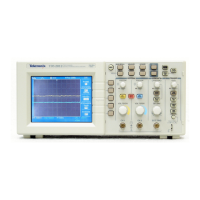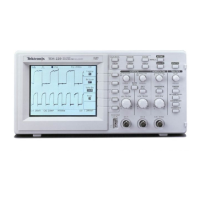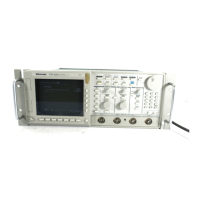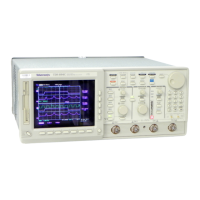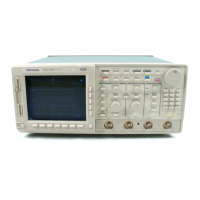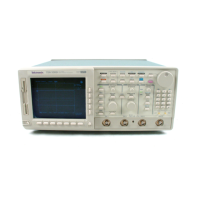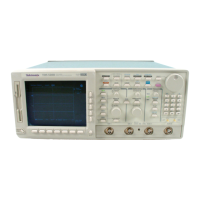Basic Concepts
TDS 200-Series Digital Oscilloscope User Manual
19
The next table lists the time bases that you should use to avoid
aliasing at various frequencies and the respective sample rate.
Time base
Samples
per second
Maximum
frequency
Time base
Samples
per second
Maximum
frequency
1.0 ms
250.0 MS/s 125.0 MHz* 5.0 ms 50.0 kS/s 25.0 kHz
2.5 ms
100.0 MS/s 50.0 MHz* 10.0 ms 25.0 kS/s 12.5 kHz
5.0 ms
50.0 MS/s 25.0 MHz* 25.0 ms 10.0 kS/s 5.0 kHz
10.0 ms
25.0 MS/s 12.5 MHz* 50.0 ms 5.0 kS/s 2.5 kHz
25.0 ms
10.0 MS/s 5.0 MHz* 100.0 ms 2.5 kS/s 1.25 kHz
50.0 ms
5.0 MS/s 2.5 MHz 250.0 ms 1.0 kS/s 500.0 Hz
100.0 ms
2.5 MS/s 1.25 MHz 500.0 ms 500.0 S/s 250.0 Hz
250.0 ms
1.0 MS/s 500.0 kHz 1.0 s 250.0 S/s 125.0 Hz
500.0 ms
500.0 kS/s 250.0 kHz 2.5 s 100.0 S/s 50.0 Hz
1.0 ms 250.0 kS/s 125.0 kHz 5.0 s 50.0 S/s 25.0 Hz
2.5 ms 100.0 kS/s 50.0 kHz
* Bandwidth is not valid for the P2100 probe when the switch is set to 1X.
There are various ways to prevent aliasing: adjust the horizontal
scale, push the AUTOSET button, or change the acquisition mode.
NOTE. If aliasing occurs, change to the Peak Detect acquisition
mode (described on page 16). This mode samples the highest and
lowest values so that the oscilloscope can detect faster signals.

